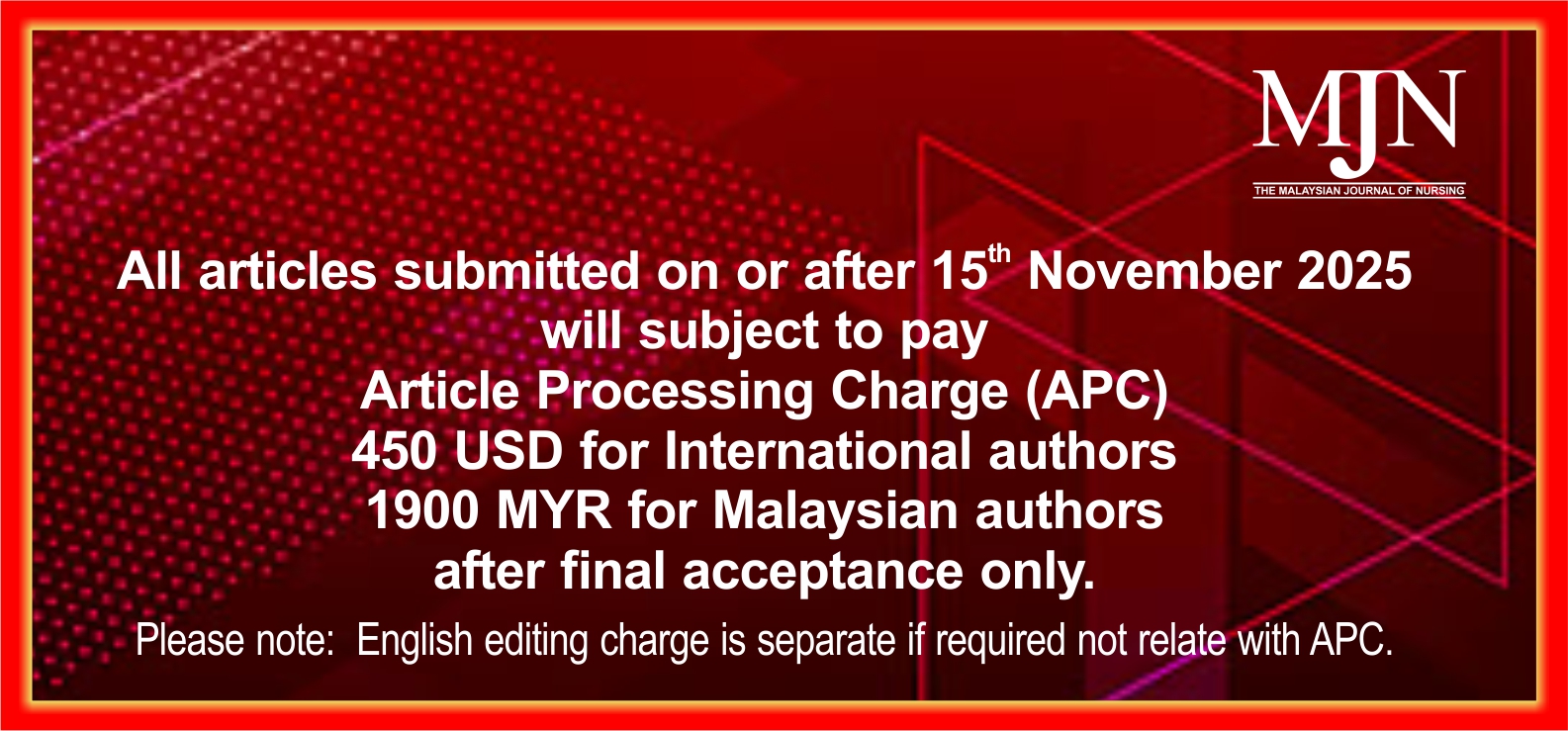Development and Validation of a Revised VAS-Anxiety Measurement Tools for Preschool Hospitalized Children
DOI:
https://doi.org/10.31674/mjn.2023.v14i03.006Abstract
Background: The visual analogue scale (VAS) instrument is proven to be reliable in measuring anxiety. Experts argue, however, that measuring the aspect of psychosocial trauma in a different language has limitations, especially among hospitalised children under the age of six. As a result, the study sought to revise and validate a trustworthy, child-friendly VAS for use in Indonesia. Methods: A preliminary survey was conducted among 81 respondents that met the inclusion criteria. An expert committee reviewed and revised the VAS-Anxiety-Indonesia for sensitivity and content validity. Thus, the Centre of Indonesia Language was charged with forward and backward translation from English to Indonesian and vice versa. In this study, data were collected in two phases. The first was the preliminary data collection from 21 respondents for face and content validity. The second phase recruited 60 respondents with retests and confirmations of modified items and components of VAS-A-Indonesia. Statistical analysis used a Pearson correlation coefficient of 0.05. The second test performed the content validity index, item correlation analysis, internal consistency for reliability testing, and Exploratory Factor Analysis. Results: The instrument consists of 12 items. With three factors to measure anxiety, they accounted for 65.2% of the overall variance. The content validity index was 0.825 (Aiken's V), item correlations ranged from 0.354 to 0.686, and Cronbach's alpha was 0.837. Conclusion: The Indonesian version of the VAS-A was a valid and reliable instrument for assessing the anxiety of preschoolers admitted to hospitals.
Keywords:
Visual Analog Scale, Anxiety, Children, Hospitalization, Validity and ReliabilityDownloads
References
Abend, R., Dan, O., Maoz, K., Raz, S., & Bar-haim, Y. (2014). Journal of Behavior Therapy and Reliability , validity and sensitivity of a computerized visual analog scale measuring state anxiety. Journal of Behavior Therapy and Experimental Psychiatry, 45(4), 447–453. https://doi.org/10.1016/j.jbtep.2014.06.004
Acosta-Banda, A., Aguilar-Esteva, V., Ortiz, M. P., & Ortiz, J. P. (2021). Construction and validity of an instrument to evaluate renewable energies and energy sustainability perceptions for social consciousness. Sustainability (Switzerland), 13(4), 1–13. https://doi.org/10.3390/su13042333
An Gie Yong, S. P. (2013). A Beginner’s Guide to Factor Analysis: Focusing on Exploratory Factor Analysis. Tutorials in Quantitative Methods for Psychology, 9(2), 79–94. https://doi.org/10.20982/tqmp.09.2.p079
Bernstein, G. A., & Garfinkel, B. D. (1992). The visual analogue scale for anxiety - Revised: Psychometric properties. Journal of Anxiety Disorders, 6(3), 223–239. https://doi.org/10.1016/0887-6185(92)90035-6
Bolarinwa, O. (2015). Principles and methods of validity and reliability testing of questionnaires used in social and health science researches. Nigerian Postgraduate Medical Journal, 22(4), 195. https://doi.org/10.4103/1117-1936.173959
Budiastuti, D., & Bandur, A. (2018). Validitas dan reliabilitas penelitian. Jakarta: Mitra Wacana Media.
Cannavan, P. M. S., De Souza Cannavan, F. P., Oliveira, H. C., Walfridsson, U., & De Moraes Lopes, M. H. B. (2021). A Brazilian Portuguese translation, cultural adaptation and validation of the Arrhythmia-Specific questionnaire in Tachycardia and Arrhythmia (ASTA) health-related quality of life (HRQOL) scale. PLoS ONE, 16(8 August), 1–15. https://doi.org/10.1371/journal.pone.0256851
Chung, J. O. K., Li, W. H. C., Wei, X., Cheung, A. T., Ho, L. L. K., & Chan, G. C. F. (2021). Translation and psychometric evaluation of the Chinese version of the resilience scale for children with cancer. Health and Quality of Life Outcomes, 19(1), 1–9. https://doi.org/10.1186/s12955-021-01865-y
Croke, L. (2020). Nonpharmacologic strategies to help reduce preoperative patient anxiety. AORN Journal, 111(2), P8–P10. https://doi.org/10.1002/aorn.12970
Csonka, S. (2021). Why be afraid of the night ? - Pedagogical methods for developing positive attitudes towards natural darkness in order to reduce light pollution. 11(2), 18–35. https://doi.org/10.24368/jates.v11i2.222
Godino-Iáñez, M. J., Martos-Cabrera, M. B., Suleiman-Martos, N., Gómez-Urquiza, J. L., Vargas-Román, K., Membrive-Jiménez, M. J., & Albendín-García, L. (2020). Play therapy as an intervention in hospitalized children: A systematic review. Healthcare (Switzerland), 8(3), 1–12. https://doi.org/10.3390/healthcare8030239
Gliem, J. A., & Gliem, R. R. (2003). Calculating, interpreting, and reporting Cronbach’s alpha reliability coefficient for Likert-type scales. Midwest Research-to-Practice Conference in Adult, Continuing, and Community Education.
Hair J. F., Black W. C. Babin B. J., & Anderson R. E. (2019). Multivariate data analysis (Eighth). Pearson New International Edition. UK.
Handayani, A., & Daulima, N. H. C. (2020). Parental presence in the implementation of atraumatic care during children’s hospitalization. Pediatric Reports, 12. https://doi.org/10.4081/pr.2020.8693
Howard, M. C. (2016). A Review of Exploratory Factor Analysis Decisions and Overview of Current Practices: What We Are Doing and How Can We Improve? International Journal of Human-Computer Interaction, 32(1), 51–62. https://doi.org/10.1080/10447318.2015.1087664
Igwesi-Chidobe, C. N., Muomah, R. C., Sorinola, I. O., & Godfrey, E. L. (2021). Detecting anxiety and depression among people with limited literacy living with chronic low back pain in Nigeria: adaptation and validation of the hospital anxiety and depression scale. Archives of Public Health, 79(1), 1–16. https://doi.org/10.1186/s13690-021-00586-4
Islaeli, I., Yati, M., Islamiyah, & Fadmi, F. R. (2020). The effect of play puzzle therapy on anxiety of children on preschooler in Kota Kendari hospital. Enfermeria Clinica, 30, 103–105. https://doi.org/10.1016/j.enfcli.2019.11.032
Jiang, M., Ma, Y., Li, M., Meng, R., Ma, A., & Chen, P. (2021). A comparison of self-reported and proxy-reported health utilities in children: a systematic review and meta-analysis. Health and Quality of Life Outcomes, 19(1), 1–14. https://doi.org/10.1186/s12955-021-01677-0
Kaiser, H. F. (1974). An index of factorial simplicity. Psychometrika, 39(1), 31–36. https://doi.org/10.1007/BF02291575
Kleye, I., Hedén, L., Karlsson, K., Sundler, A. J., & Darcy, L. (2021). Children’s individual voices are required for adequate management of fear and pain during hospital care and treatment. Scandinavian Journal of Caring Sciences, 35(2), 530–537. https://doi.org/10.1111/scs.12865
Leibring, I., & Anderzén-Carlsson, A. (2022). Young children’s experiences of support when fearful during treatment for acute lymphoblastic leukaemia—A longitudinal interview study. Nursing Open, 9(1), 527–540. https://doi.org/10.1002/nop2.1092
Li, W. H. C., Chung, J. O. K., Ho, K. Y., & Kwok, B. M. C. (2016). Play interventions to reduce anxiety and negative emotions in hospitalized children. BMC Pediatrics, 16(36), 1–9. https://doi.org/10.1186/s12887-016-0570-5
Mahakwe, G., Johnson, E., Karlsson, K., & Nilsson, S. (2021). A Systematic Review of Self-Report Instruments for the Measurement of Anxiety in Hospitalized Children with Cancer. International Journal of Environmental Research and Public Health, 18. https://doi.org/10.3390/ijerph18041911
Morgado, F. F. R., Meireles, J. F. F., Neves, C. M., Amaral, A. C. S., & Ferreira, M. E. C. (2017). Scale development: Ten main limitations and recommendations to improve future research practices. Psicologia: Reflexao e Critica, 30(1), 1–20. https://doi.org/10.1186/s41155-016-0057-1
Naunheim, M. R., Dai, J. B., Rubinstein, B. J., Goldberg, L., Weinberg, A., & Courey, M. S. (2020). A visual analog scale for patient-reported voice outcomes: The VAS voice. Laryngoscope Investigative Otolaryngology, 5(1), 90–95. https://doi.org/10.1002/lio2.333
Nursalam. (2013). Nursing Research Methodology: Practical Approaches 3rd edition (Aklia Suslia (ed.)). Salemba Medika.
Ramdan, I. M. (2019). Reliability and Validity Test of the Indonesian Version of the Hamilton Anxiety Rating Scale (HAM-A) to Measure Work-related Stress in Nursing. Jurnal Ners, 14(1), 33. https://doi.org/10.20473/jn.v13i2.10673
Salmela, M., Aronen, E. T., & Salanterä, S. (2011). The experience of hospital-related fears of 4- to 6-year-old children. Child: Care, Health and Development, 37(5), 719–726. https://doi.org/10.1111/j.1365-2214.2010.01171.x
Salmela, M., Salanterä, S., & Aronen, E. T. (2010). Coping with hospital‐related fears: experiences of pre‐school‐aged children. Journal of Advanced Nursing, 66(6), 1222-1231. https://doi.org/10.1111/j.1365-2648.2010.05287.x
Samuels, P. (2016). Advice on Exploratory Factor Analysis. Centre for Academic Success, Birmingham City University, June, 2. https://doi.org/10.13140/RG.2.1.5013.9766
Takemura, Y., Kido, K., Kawana, H., Yamamoto, T., Sanuki, T., & Mukai, Y. (2021). Effects of green color exposure on stress, anxiety, and pain during peripheral intravenous cannulation in dental patients requiring sedation. International Journal of Environmental Research and Public Health, 18(11). https://doi.org/10.3390/ijerph18115939
Tsang, S., Royse, C. F., & Terkawi, A. S. (2017). Guidelines for developing, translating, and validating a questionnaire in perioperative and pain medicine. Saudi Journal of Anaesthesia, 11, S80–S89. https://doi.org/10.4103/sja.SJA_203_17
Wilkins, L. W. (2020). Concepts in pediatric nursing care Just the facts (Issue 2014, pp. 13–60).
Yusoff, M. S. B. (2019). ABC of Content Validation and Content Validity Index Calculation. Education in Medicine Journal, 11(2), 49–54. https://doi.org/10.21315/eimj2019.11.2.6
Zimmerman, M., Kiefer, R., Kerr, S., & Balling, C. (2019). Reliability and validity of a self-report scale for daily assessments of the severity of anxiety symptoms. Comprehensive Psychiatry, 90, 37–42. https://doi.org/10.1016/J.COMPPSYCH.2018.12.014
Published
How to Cite
Issue
Section
License
Copyright (c) 2023 The Malaysian Journal of Nursing (MJN)

This work is licensed under a Creative Commons Attribution-NonCommercial-NoDerivatives 4.0 International License.



































